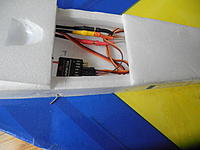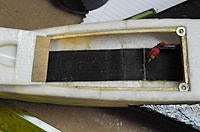Comments (0)
Add Comment
-
 Views: 999
Views: 999
Polaris #1 showing how half plastic spoons are used to provide cooling. Alternative is an external heat sink. -
 Views: 895
Views: 895
Polaris #3 battery hatch showing magnets and steel washers. Hatch is hinged at the front with tape. Industrial strength Velcro on the floor. -
 Views: 849
Views: 849
Radio compartment with AR6110 receiver. ESC is just out of the picture to the left, as shown by the wires. Note that one antenna pokes through the fuselage side to allow the Rx to be mounted a litt further from the wiring. -
 Views: 899
Views: 899
HS-55 servos in Polaris #1. The hatch was made afterwards because I needed to do some adjustment. Not normally required. -
 Views: 838
Views: 838
Polaris #1 battery hatch. Magnets are on the hatch on this one. -
 Views: 847
Views: 847
Polaris #1 radio installation with FrSky receiver. Antennas are taped to the wings. Wood surround is not really needed.



